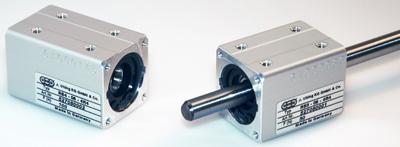
Amacoil/Uhing has expanded its line of Model RS rolling ring linear drive nuts with the new RS8 drive. The new unit runs on an 8mm diameter case hardened and ground, smooth shaft and supports space-saving machine design trends toward smaller components. Currently being used in small axis optical metrology machines, the RS8 nut is the smallest drive in the RS line, yet it provides the same axial thrust (100 Newtons) as the next larger size drive unit. This permits a slightly smaller overall design envelope without loss of thrust capacity.
The RS8 linear drive runs on a smooth shaft. There are no threads where debris may be trapped and cause clogs or jams. This provides built-in overload protection because if the system is somehow overloaded, the nut will slip and not jam. Drive system components are thereby protected from possible damage that may result from the churning and grinding that sometimes occurs with linear drive devices. The result is less downtime required for cleaning threads and making repairs and this facilitates more consistent production rates.
The new drive housing is made from an extruded aluminum profile. The nut has a standard linear pitch of 4mm. Four other pitch settings are available (mm): 3.2, 2.4, 1.6 and 0.8. An optional free movement lever may be used which enables manual sliding of the drive on the shaft. If an application calls for frequent use of the free movement lever, there is an option to pneumatically actuate the free movement function which prevents excessive wear and extends the life of the drive.
Like all Model RS drives, the new RS8 features zero backlash linear motion. The inner race of each rolling ring bearing is in constant point-contact with the shaft. There is no play or free movement between shaft and bearings — even during reversal. This assures that when the shaft rotates the rotary motion input is immediately converted into linear output.
Machine designers requiring backlash-free linear motion will find applications for the RS8 drive in a variety of automated manufacturing processes in industries including packaging, converting, textile, automotive, metrology and CNC machining. Ten models of the RS drive nut are available each with a specific axial thrust capacity. RS drive accuracy is dependent on the type of controls used. No maintenance is required except light lubrication of the shaft once per month.
Related Glossary Terms
- backlash
backlash
Reaction in dynamic motion systems where potential energy that was created while the object was in motion is released when the object stops. Release of this potential energy or inertia causes the device to quickly snap backward relative to the last direction of motion. Backlash can cause a system’s final resting position to be different from what was intended and from where the control system intended to stop the device.
- computer numerical control ( CNC)
computer numerical control ( CNC)
Microprocessor-based controller dedicated to a machine tool that permits the creation or modification of parts. Programmed numerical control activates the machine’s servos and spindle drives and controls the various machining operations. See DNC, direct numerical control; NC, numerical control.
- grinding
grinding
Machining operation in which material is removed from the workpiece by a powered abrasive wheel, stone, belt, paste, sheet, compound, slurry, etc. Takes various forms: surface grinding (creates flat and/or squared surfaces); cylindrical grinding (for external cylindrical and tapered shapes, fillets, undercuts, etc.); centerless grinding; chamfering; thread and form grinding; tool and cutter grinding; offhand grinding; lapping and polishing (grinding with extremely fine grits to create ultrasmooth surfaces); honing; and disc grinding.
- metrology
metrology
Science of measurement; the principles on which precision machining, quality control and inspection are based. See precision machining, measurement.
- pitch
pitch
1. On a saw blade, the number of teeth per inch. 2. In threading, the number of threads per inch.
